
Get Business Email
No domain name required
Is your inbox always full of emails? Gmail can quickly fill up your inbox with messages, but there’s an easy way to keep emails from getting lost in the clutter. The popular email service provider has the option to create folders or "labels," so your emails go to the right place within your account.
Gmail labels are a powerful tool that enables you to organize your inbox and makes it easier to find specific emails. Unlike traditional folders, these Google labels enable you to assign multiple labels to a single email.
This, in turn, gives you more flexibility and customization options. This also means you can categorize a particular email in several ways, which will make it easier to locate later. For instance, an email from one of your clients about a project can be labeled both under “Client” and “Project.” This ensures you can find the message regardless of the context you’re searching in.
However, you must also know how to create a folder in Gmail to ensure an organized system for managing your messages. This guide will discuss how to organize Gmail folders in a few easy steps so that you can find important emails and maintain a well-organized inbox without any hassle.
Gmail Labels: How to Organize Gmail?
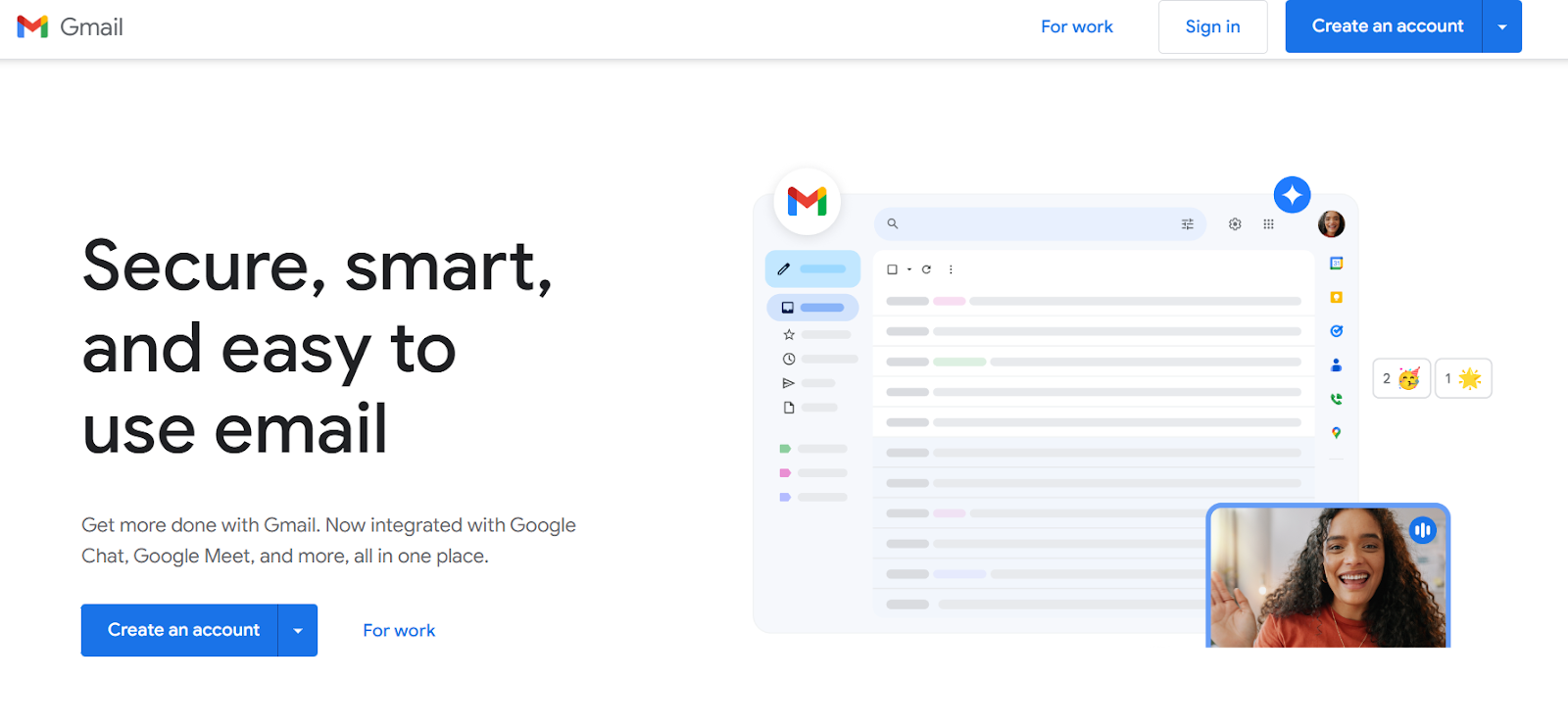
Gmail labels enable you to reduce the time spent searching for crucial messages by streamlining the email management process. Whether you are managing personal emails or coordinating with your team, these labels can help you keep your inbox organized and efficient at all times.
Team members can create labels to categorize emails sent, received, or drafted in a Gmail folder that are scheduled for a particular date and time. In other words, these labels are a simple way for you to organize and declutter your inbox. They are accessible from the left sidebar of your Gmail, often displayed with an arrow-shaped icon.
Gmail labels are often referred to as folders in professional or business contexts. Their crucial features include:
- Organization: Labels or folders are inevitable in Gmail's overall management system. They often serve as the primary tags for your emails.
- Customization: Gmail also allows you to apply multiple labels or folders to a single email, which enhances your organization's strategy.
- Visibility: Gmail labels often appear in the inbox view next to the subject when applied to a particular email. This gives you quick insights about the email in question at a glance.
How to Create a Folder for Gmail on a Desktop
As mentioned earlier, folders are called ‘labels’ in Gmail. Here is how you can create a folder for your Gmail on your desktop for professional or business purposes in a few simple steps:
- Go to your browser and open Gmail.
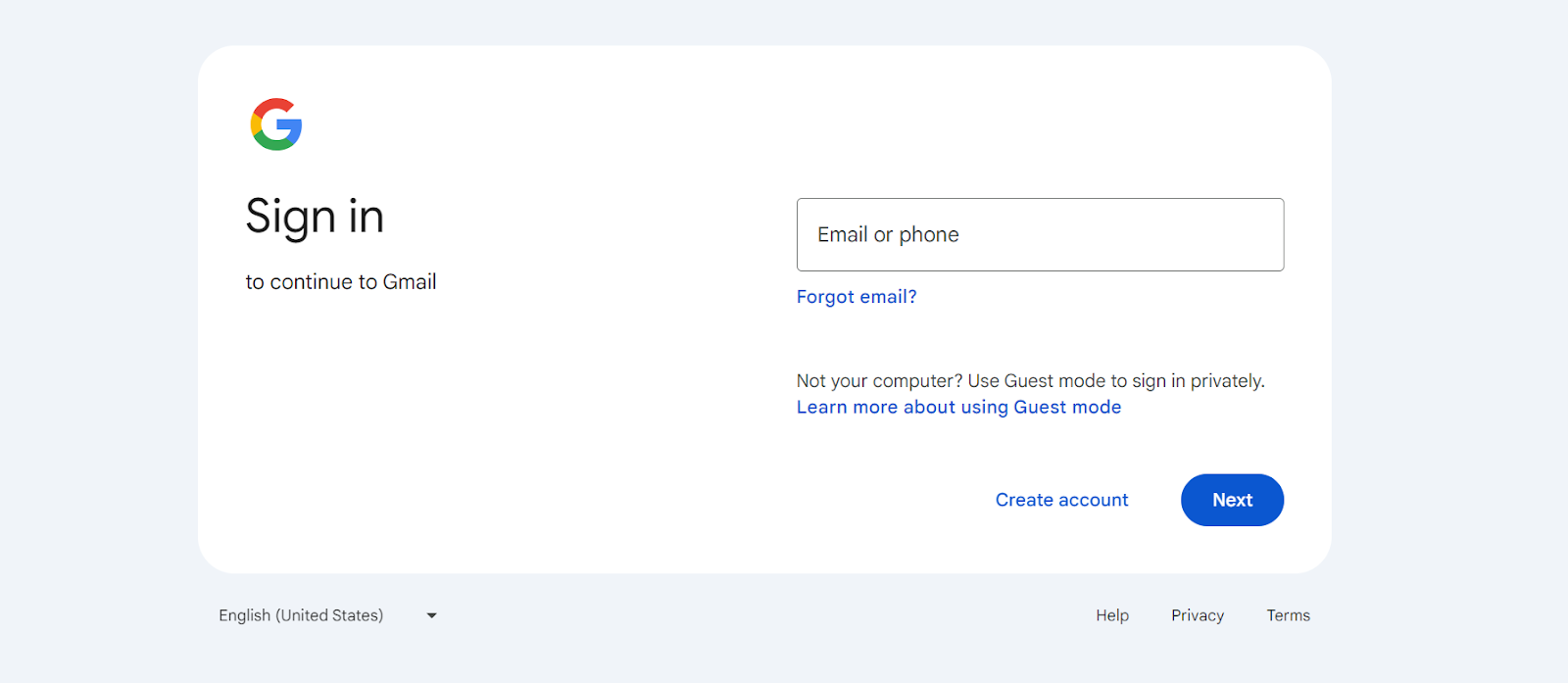
- Click More on the left-hand menu of your inbox.
- Select the option saying Create new label.
4. Name your label in the pop-up window.
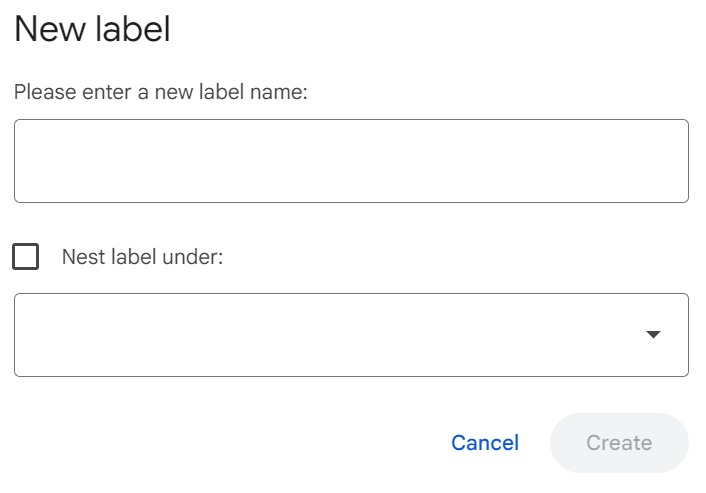
5. Click on the Create option.
Your new folder will be live under the Labels section of your Gmail inbox.
Alternative Way to Create a Folder on Gmail
There is another easy way to create your folder or label on Gmail. You must navigate to the settings section of your account and follow the steps below for this process:
- Click on the Settings icon of your Gmail, followed by See All Settings.
- Select the Labels tab.
- Click on the Create New Label option that you can see at the bottom of the Gmail page.
- Name your new label.

- Then, click on Create again.
- You will see a section named Nest Label Under where you can create other subfolders, too.
If you do not have a laptop or computer, you can easily create folders or labels for Gmail on your mobile. Open the Gmail app and click on the menu icon at the top left corner of your phone’s screen. Next, navigate to the Labels section and select the Create New option. Name your label accordingly and click on Save.
How to Edit or Delete Folders for Gmail
Gmail makes it easier for you to edit, delete, and even manage labels that you already created on your account. Here’s how:
1. Editing a Label on Gmail
Here is an overview of the steps to undertake when editing a label on Gmail:
- Go to your browser and open Gmail. Navigate to the Label section in the sidebar.
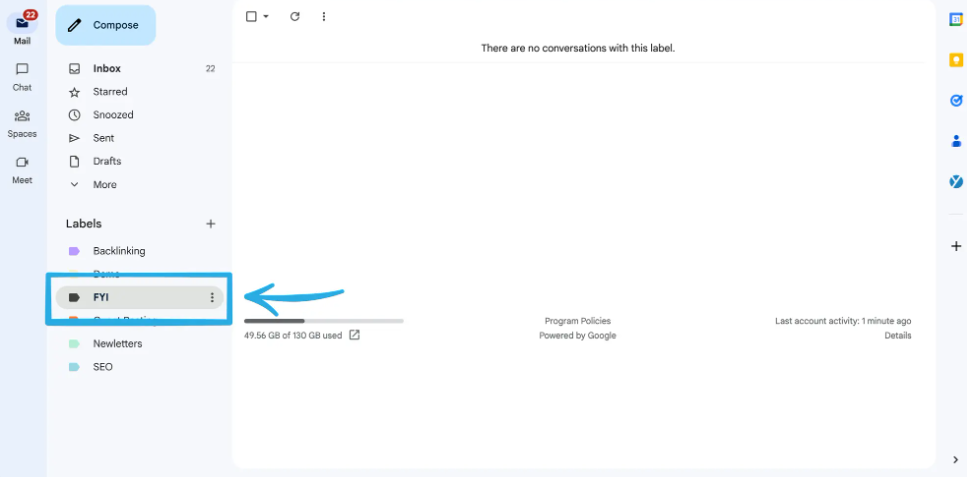
- Go to the three dots and then click on Edit.
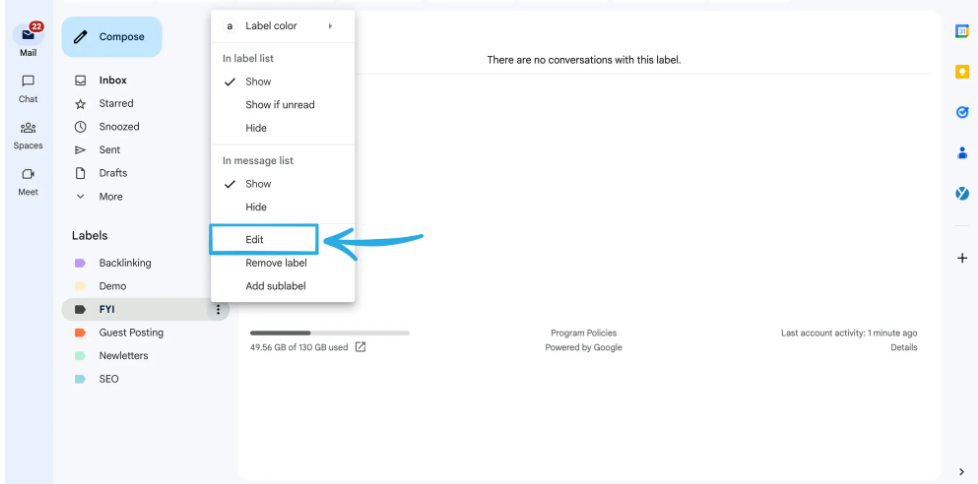
- Edit your label.
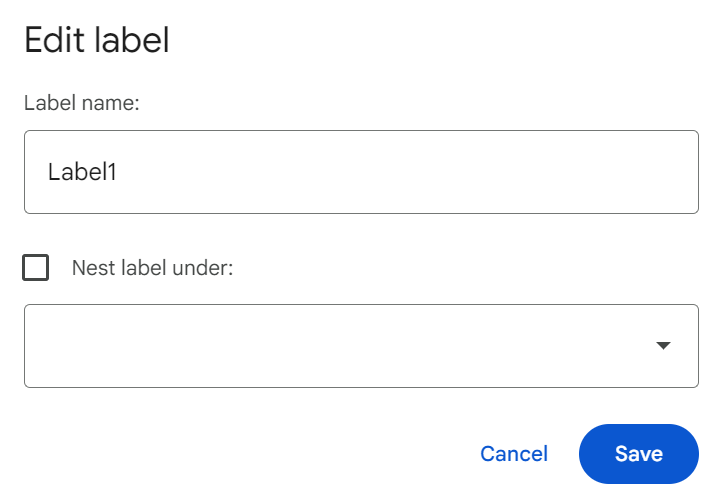
- Click on Save.
2. Deleting a Label on Gmail
- Go to your browser and open Gmail. Navigate to the Label section in the sidebar.

- Go to the three dots and select Remove Label.
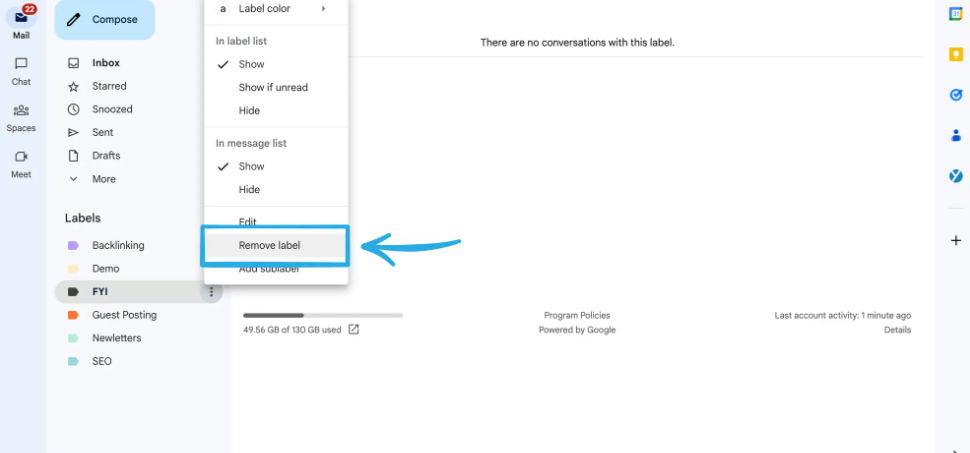
- Click on Delete in the pop-up window.
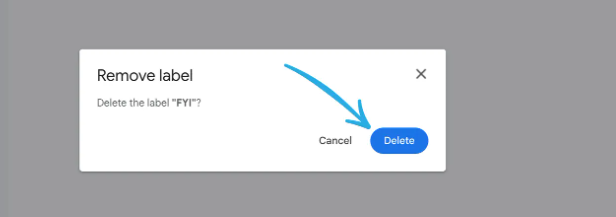
How to Label a Message in Your Gmail Inbox
Your Gmail may already be filled with messages before you begin creating labels to categorize them for better interface visibility. Do not worry because there is another way to categorize the existing emails into labels. The steps include:
- Go to your browser and open Gmail.
- Open the message you want to categorize and click on the three dots on the top of the screen.


- Click on the Labels option from the drop-down menu.
- Type a New Label or check off the one that you want to archive the message into for future purposes.
- Click on the Apply option. You can also add labels to multiple messages by selecting the emails from the inbox view and clicking on the Label button.
How to Label an Email While Writing It?
Gmail also enables you to label outgoing messages that you have yet to send to the respective recipients. The steps include:
- Go to your browser and open Gmail. Click on the Compose option.

- Click on the three vertical dots on the bottom right of the compose window.

- Click on the Label option.

- Type a new label or check off the label you want to archive the message into for future purposes. Then click on the Apply option.
Labeling Emails Automatically Based on Search Criteria
Categorizing emails into folders or labels on Gmail may be overwhelming if you are busy with other tasks. That is why you need to know how to label your emails automatically, as showcased below.
- Go to your browser and open Gmail. Click on the gear icon near the Search bar at the top of the page.

- Determine your criteria.
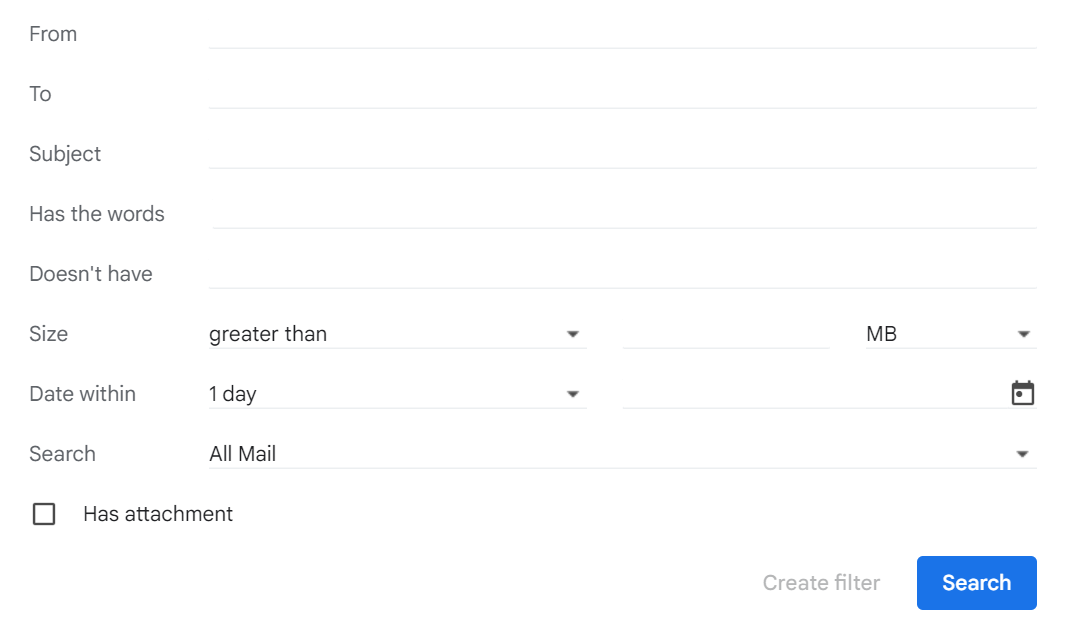
- Click on Create Label at the bottom right corner of the search window.

- Check off the Apply the Label option by choosing the specific folder of your choice from the drop-down menu.
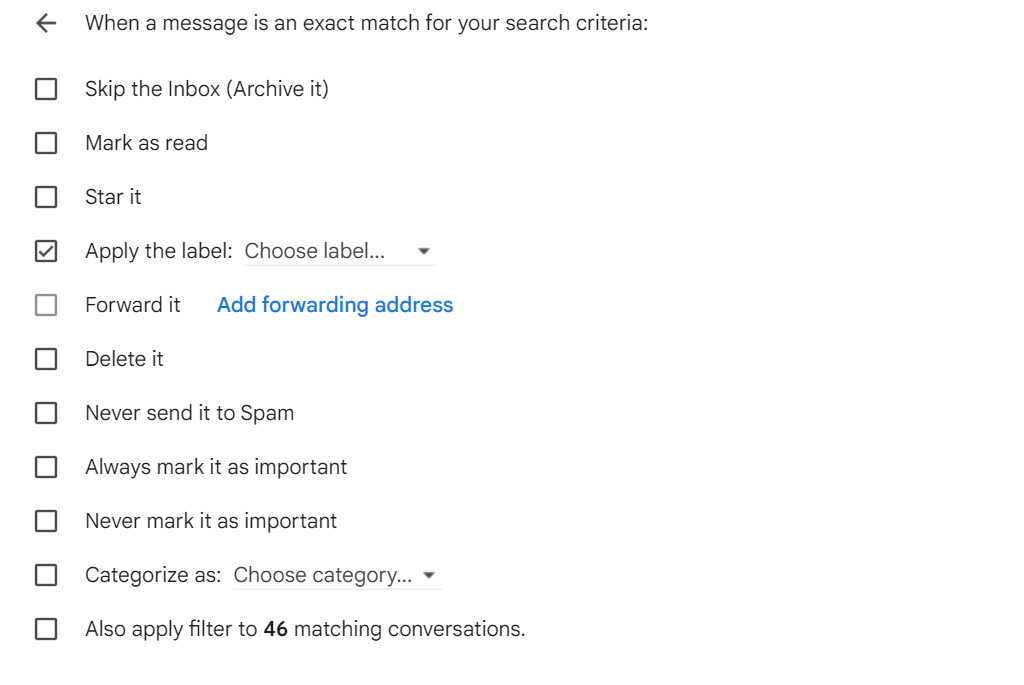
- Then, Click on Create Filter.
Benefits of Using Gmail Folders or Labels
Gmail has been offering folders or labels for filtering your emails since the beginning. But have you ever wondered why these folders are considered important? If not, here’s the answer:
1. Multiple Labels for a Single Email
Gmail labels allow you to apply multiple labels to a single email. It means that a particular email from your manager or team leader about an upcoming project can be labeled as both "Work" and "Projects." It also means you can access the messages from either category.
2. Color-coding for Quick Identification
Visual cues can often significantly speed up the process of identifying and sorting emails. Gmail Labels can be easily color-coded, enabling you to recognize an email's nature or priority instantly.
Here’s how you can do it: Go to the label section, hover your mouse over the desired label, click on the three dots that appear to its right, and select label color. You can choose a label color from the pre-defined options or add a custom color. Once you are done selecting the color, click on Apply.
3. Efficient Integration with Filters
Gmail labels work with filters, which means you can set up rules to automatically label incoming emails based on specific criteria. This may involve analyzing the sender's address or keywords in the respective subject line. This automation process ensures that all your emails are categorized the moment they arrive in your inbox, saving you time and effort.
4. Flexibility in Visibility
Not all labels are equally important to you at all times. Gmail enables you to choose which labels are visible in your sidebar and which ones must remain hidden until you need them. This flexibility ensures that you have an uncluttered sidebar with access to all your labels when necessary.
5. Enhanced Search Functionality
You can also include label names in your search query to narrow down the results when searching for a particular email. This specific integration with Gmail's search functionality ensures that you can find the exact email you are looking for quickly.
6. Team Collaboration
Labels can act as indicators or status markers for professionals using Gmail shared inboxes or collaborating on projects. A particular email can also be labeled "Reviewed" or "Pending Approval" to keep everyone in the loop about its status. The value of Gmail labels often extends far beyond your personal email organization. These special folders form a critical part of the most effective team communication strategies.
7. Iterative Labeling
Iterative labeling is another advanced strategy associated with Gmail labels that you can employ for your email communication. This often involves updating labels based not just on the status. It also serves as a way for your team members to track their progress and history of a particular project right from their inbox.
8. Archiving Without Deletion
Gmail labels allow you to archive emails without deleting them. This ensures your inbox stays clutter-free while still retaining access to important messages. Archived emails remain accessible through their assigned labels, so you can retrieve them easily whenever needed. This helps maintain a clean inbox while preserving valuable information for future reference.
9. Efficient Mobile Access for Labels
Gmail labels sync effortlessly across devices, ensuring your organized email structure remains intact whether you are on your computer, smartphone, or tablet. This unique consistency allows you to manage, search, and sort emails on the go. It also gives you full control over your inbox no matter where you are.
Top Label Tips to Keep Your Gmail Folder Up-to-date
You may need to tweak your labels after creating them. Whether you want to rename, delete, or remove it altogether, Gmail has a simple solution within the Labels Tab of Settings.
All you need to do is click More on the left side of your Gmail inbox and then Manage Labels. On that note, here is a list of tips to ensure you manage your folders efficiently:
- Use Multiple Labels: Assign various labels to a single email in your Gmail to categorize it accordingly. This flexibility enables you to find your emails based on various contexts.
- Create Nested Labels: You may also create some nested labels to organize related emails under a parent label. For example, your parent label can be “Projects”, and nested labels can have the names for each specific project. The same goes for other categories like Clients, Departments, and Employees.
- Use Labels for Notifications: Use your Gmail labels to control which messages trigger notifications. This allows for more customized notification settings.
- Keep Your Label List Organized: To keep your labels organized, you may choose to show or hide them as needed. This helps you maintain a clean and focused Gmail inbox.
- Use Labels for Smarter Searches: Labels can be crucial variables in searches to narrow down results. This will make it easier for you to find specific messages in the future.
- Apply Labels While Composing: You can also apply labels to new messages while composing. This enables you to ensure that the specific email and its associated replies remain organized.
- Let Gmail Apply Labels: The email service provider can create labels for your messages based on specific criteria. This is usually done using Gmail filters or Gmelius rules. It will save you time and also streamline your email management.
- Use Label-specific Notifications: If you use the Gmail app on your phone, you can set notifications for specific labels. This way, you will be alerted only for emails that matter most.
- Mute Less Important Labels: Consider muting their notifications for Gmail labels that aren't time-sensitive. This reduces distractions and allows you to block focused work periods.
- Prioritize with Starred Emails: Use the 'Star' feature for emails alongside labels for messages that require immediate attention. This way, you won't miss out on crucial emails even if you have notifications muted for a label.
Bottom Line
You may receive multiple messages on your Gmail every day. This calls for the need for labels or folders that enable you to categorize your messages based on specific criteria. However, you must know how to create a folder for Gmail to ensure your email is organized accordingly. Make sure you add nested labels for the ones that require further sub-categorization, allowing you to group similar emails under broader categories for easier access and better organization.
However, email hosting services, such as Neo, can further enhance your email experience. Neo offers a free .co.site domain name, email read reciepts and custom email address for your business. Visit Neo to learn more about how it can help you streamline your marketing efforts.
Frequently Asked Questions(FAQs)
1. How do I organize Gmail emails into folders?
You can use labels and search filters to organize your Gmail emails into folders. You can drag all messages into labels or folders as per your references. You can also apply multiple labels to a message and find them by clicking any of their labels in the left panel.
2. How do you automatically move emails after creating a Gmail folder?
Start by selecting the message group on Gmail and hitting the Create Rule button on the bottom action bar. In the Apply Action section, you must opt for Move to. Choose an existing Gmail folder or enter a new folder name before selecting Create (folder).
3. Can I email folders in Gmail?
You can easily email a folder in Gmail by zipping it on your computer and attaching the ZIP file later, which usually contains the folder in your email. Please note that all attachments in Gmail have to be less than 25 MB, even if you are attaching a ZIP file.
4. How can I create an email on Gmail?
Go to the Google account sign-in page from your device and click on Create Account. From the drop-down menu, select whether you want an account for personal use, work, or business. Follow the subsequent steps on the screen to set up your account.

Get Business Email
No domain name required





.svg%201.svg)
.svg)
.svg)
.svg%201.svg)



